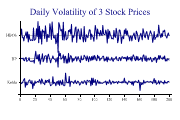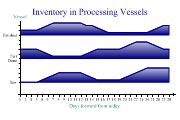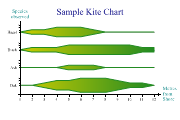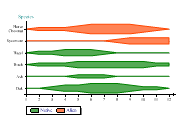| Professional charting tools for .Net developers |
Introducing SharpPlot
Your First Chart
Recent Updates
Tutorials
General Tutorials
Chart Tutorials
Reference
SharpPlot Class
Properties
Methods
Structures
Enumerations
Style examples
Glossaries
Active Charts
VectorMath Class
DBUtil Class
Get SharpPlot
Download SharpPlot
Buying SharpPlot
SharpPlot Support
Upgrading from GraPL
Release notes
Home > Sample Charts > TraceChart > Several Parallel Timeseries
Several Parallel Timeseries
Trace charts are a slightly specialist style of plot, originally designed for data from devices like seismographs and EEGs where multiple pens trace out (almost) parallel lines. Each pen is allocated a tickmark on the Y-axis and then an ‘inner axis’ is created for it (naturally these inner axes are all scaled identically).
This chart takes the ‘delta’ of three popular stock prices and shows the daily volatility of each. Note that both BP and the Halifax Bank show the spike around day-50 (the invasion of Iraq) but Kelda (a utility stock) was completely unaffected.
If the series tend to move very closely together, you can set the Inner-axis range to quite a big number (say 1.8) to allow each series to stray into the band occupied by its neighbours. This would be typical of a multiple pen-plotter such as a seismograph.

SharpPlot sp = new SharpPlot; sp.Heading = "Daily Volatility of 3 Stock Prices"; bp = VectorMath.Difference(new int[] {427,428,427,429,424,418,420,424,416,410,406, 409,403,395,389,380,374,369,356,362,383,383,382,393,386,398,382,379,380, 394,385,381,388,396,404,393,400,413,417,414,402,400,400,408,408,406,405, 395,392,395,371,392,400,415,413,414,417,428,416,422,429,416,414,401,416, 406,407,416,421,411,412,406,405,408,414,407,408,414,412,406,395,403,400, 397,395,405,411,414,408,416,416,407,413,414,408,414,410,418,415,424,428, 424,418,428,430,436,430,430,429,432,439,446,439,438,433,438,429,434,431, 428,424,420,424,420,412,412,410,412,418,414,410,404,407,410,404,405,411, 415,415,419,419,423,416,423,420,423,426,422,428,421,425,436,442,439,433, 440,436,442,437,435,432,436,437,429,437,448,448,442,450,442,441,443,439, 436,440,438,429,422,423,419,423,426,415,415,413,422,420,429,432,432,430, 435,434,442,435,433,426,426,425,421}); kelda = VectorMath.Difference(new int[] {424,420,418,421,429,440,426,427,419,413, 415,421,428,428,424,429,411,408,399,403,400,400,402,404,404,412,416,411, 421,426,423,420,413,419,418,423,428,428,437,434,424,416,410,426,422,422, 420,410,411,414,408,413,404,409,408,401,408,400,390,381,407,412,410,410, 408,425,413,415,418,419,420,416,419,425,423,419,422,425,424,416,411,411, 414,411,408,412,416,415,408,414,419,421,426,430,420,432,425,437,436,437, 445,436,434,440,440,436,438,435,433,430,427,427,428,429,433,426,428,426, 423,430,432,426,424,427,430,427,428,427,429,430,426,429,430,430,430,428, 431,429,430,442,440,442,441,435,435,439,441,440,442,436,438,429,432,432, 436,438,438,437,443,442,419,419,412,410,404,410,408,406,408,409,412,413, 414,415,418,418,420,416,420,431,429,435,429,425,423,428,423,424,428,430, 428,428,423,428,426,426,423,425,427,430}); hbos = VectorMath.Difference(new int[] {655,672,665,659,642,639,638,647,638,647,627, 629,618,602,589,574,558,578,563,549,538,556,551,589,567,592,581,592,566, 581,589,600,590,616,619,600,602,596,589,621,638,625,662,668,660,651,651, 626,608,612,563,598,626,641,652,668,654,690,675,674,684,670,659,650,663, 672,688,690,720,700,698,691,694,714,737,716,722,739,749,738,726,744,740, 733,713,737,725,706,707,702,694,699,714,728,715,718,714,708,690,694,721, 735,723,740,744,750,747,760,762,760,787,790,791,792,806,812,789,805,795, 806,807,804,793,784,772,785,781,774,793,800,778,766,780,794,796,772,766, 762,751,765,768,786,786,798,795,792,775,772,769,752,748,748,754,746,733, 744,750,747,728,717,716,721,718,704,722,730,725,717,722,732,730,717,716, 720,732,737,738,717,708,718,705,698,692,694,688,716,724,724,716,720,715, 727,736,750,748,744,735,736,742,740}); sp.YAxisStyle = YAxisStyles.GridLines; sp.IAxisStyle = IAxisStyles.PlainAxis; sp.SetYLabels(new string[]{"Kelda","BP","HBOS"}); sp.IAllowance = 1.5; sp.IIntercept = 0; trace = new int[][]{kelda,bp,hbos}; sp.DrawTraceChart(trace);
Worked Examples
 |
 |
 |
 |